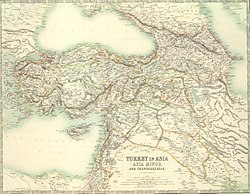Köprülü era
This article needs additional citations for verification. (May 2010) |
| History of Turkey |
|---|
 |
| Timeline |
|
|

The Köprülü era (Template:Lang-tr) (1656–1703) was the period which Ottoman Empire's politics were set by the Grand Viziers, mainly the Köprülü family, which was a notable family of imperial bureaucrats of Albanian origin.[1][2] Köprülü family generated grand viziers to the Empire, combining ambition with genuine talent. They overhauled the bureaucracy and instituted military reforms.
Several important leaders arose at this time, including the sternly reactionary Grand Vizier Mehmed Köprülü (1656–1661) and his more moderate son Fazıl Ahmed Köprülü (1661–1676). Under their leadership, the state began to reassert itself with some vigor. Despite internal conflicts within the Ottoman bureaucracy, and between the bureaucracy and military, the 17th century saw the empire expand its frontiers to its furthest reach, with notable gains under the Köprülü administration in Crete, Hungary, Southern Ukraine and Podolia.
The defeat of the Ottoman forces led by Grand Vizier Kara Mustafa Pasha at the Second Siege of Vienna in 1683, at the hands of the combined armies of Poland and the Holy Roman Empire under Jan III Sobieski, was the decisive event that swung the balance of power in the region in favor of the European nations. Under the terms of the Treaty of Karlowitz, which ended the Great Turkish War in 1699, the Ottomans ceded nearly all of Ottoman Hungary, Transylvania, the Morea and Podolia to Austria, Poland and Venice. Ottoman State also acknowledged, for the first time in its history, that the Austrian Empire could be treated on equal terms with the Ottoman Empire.
The last of the Köprülü rulers fell from power when Mustafa II (r. 1695-1703) was forced by rebellious Janissaries to abdicate. Under Ahmet III (r. 1703-30), effective control of the government passed to the military leaders. Ahmet III's reign is referred to as the "Tulip Era" because of the popularity of tulip cultivation in Istanbul during those years.
See also
References
- ^ Stephen Schwartz, The other Islam: Sufism and the road to global harmony, Doubleday 2008 ISBN 978-0-385-51819-2 page 100.
- ^ Ivo Banac: The national question in Yugoslavia: origins, history, politics, ISBN 0-8014-1675-2, ISBN 0-8014-9493-1, Cornell University 1988, page 292.
